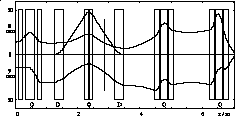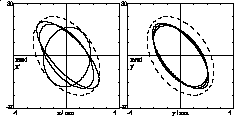GSI will replace the Wideröe prestripper linac
by an RFQ and IH-type accelerator presently under construction.
The new prestripper linac should deliver beam intensities to fill
up the heavy ion synchrotron SIS to the space charge limits for
all ions. In case of uranium the new injector has to deliver 15
emA U4+. One of the two existing ion-source terminals
has already been rebuilt for installation of the high current
sources of CHORDIS- and MEVVA-type. Therefore, investigations
of high-current beam transport have been made in the existing
LEBT. For that, additional beam diagnostic elements have been
installed: beam transformers, emittance measurement devices, residual
gas ion spectrometer. The measured beam properties, e.g. transverse
emittance, degree of space charge compensation, support the design
of the future LEBT. According to the various requirements two
layouts of the new LEBT have been studied so far.
To improve the high-current performance of the UNILAC for injection in the SIS the Wideröe prestripper accelerator will be replaced by an RFQ and an IH-type accelerator [1]. This requires also a redesign of the LEBT from the ion source to the RFQ entrance. For that, the following basic requirements on the beam dynamics have to be considered: High transmission for the high-current beam, preservation of the brilliance along the beam line, isotope seperation even for the heaviest elements, achromatic image and slope at the end of LEBT, transverse phase space matching to the RFQ, and insensitivity to space charge and energy fluctuations of the beam.
The study of the future LEBT profits greatly from beam investigations at the present beam transport system. Measurements of beam transmissions, transverse emittances, degree of space charge compensation, comparison of beam simulations with experimental data, etc. support the LEBT design considerably.
In the first part measurements on high-intensity
beams will be reported. Afterwards different layouts of a new
LEBT will be discussed.
The existing injection beam line between the high current ion source and the switching magnet has been equipped with additional beam diagnostic instruments as shown in Fig. 1.
The beam transmission has been measured by Faraday
cups and calibrated beam transformers. The transverse emittances
have been measured by slit-collector systems. These measurements
give information about the brilliance of the beam. Emittance growth
along the beam line can be detected. Also profile measurements
at different positions will support the evaluation of the beam
simulation model.

Space charge potential and build-up time of beam neutraliziation can be measured by a new residual gas ion spectrometer. Description of this system and first measurements will be reported in a separate contribution of these proceedings [2].
In Table 1 some representative results of emittance
measurements are given for different ion species delivered from
the high-current sources CHORDIS and MEVVA, the beam energy was
11.7 keV/u. The beam transfer from DB2 to DB4 (see Fig. 1) was
simulated with the ellipse transformation code MIRKO and the Monte
Carlo code PARMT.
|
|
|
| |
|
|
| ||
|
|
| ||
|
|
| ||
|
|
| ||
|
|
| ||
|
|
|
Figure 2 shows results of beam dynamics calculations at different
current levels. Measured emittances and computed phase space ellipses
at zero current coincide each other. Therefore, a high degree
of space charge compensation can be stated. This result was also
confirmed by beam width measurements behind the bending magnet
where a very small horizontal beam size was adjusted at the mass
separator slits. Figure 3 illustrates the big increase of beam
width if the beam simulation includes space charge forces. The
measured beam width agrees very well with the zero-current simulation.

Fig. 2. Transverse emittances at DB4 calculated for
different effective currents.

Fig. 3. Computed beam width at the spectrometer
slits.
The comparison of emittance areas listed in Table
1 indicates that there is no evident growth between the diagnostic
stations DB2 and DB4. This result is in full agreement with PARMT
simulations (at I = 0), higher order effects are included.
The existing LEBT as shown in Fig. 1 has been studied for the use of high-intensity beam transport for the new injector. To match the beam to the RFQ acceptance it has to be partly rebuilt. Figure 4 shows the transverse beam envelope matched by four quadrupole magnets to the RFQ acceptance. The envelope is based on an emittance of 138 mmmrad in both planes, corresponding to the RFQ acceptance.
The high current sources deliver beam pulses of 1-2 ms length and a repetition rate 5 Hz for the heavy ion synchrotron. The PIG sources serve the low energy experimental area with a second beam of up to 6 ms length and a repetition rate of 50 Hz. For future time sharing operation laminated magnets are planned.

Fig. 4. Transverse beam envelope calculations for
the existing mass spectrometer and a matching quadruplet in front
of the RFQ.
The layout of the complete LEBT including also the
PIG source beam line is presented in Fig. 5.

Fig. 5. Mechanical layout of the studied LEBT, a
shortened version of the existing LEBT.
The 77.50 spectrometer magnet performs a mass resolution m/m = 220. This allows the isotope separation of all elements which is necessary for many experiments and reduces the space charge forces in the following transport and accelerator sections.
This LEBT is achromatic only in the way that particles of different energies coincide in a focus at the RFQ entrance but unfortunately with different angles. This is shown in Fig. 6.
Emittance measurements directly behind the variable
high voltage gap (DB1 in Fig. 1) turned out that the emittance
areas are in the range of 70-90 mmmrad at the new energy of 2.2
keV/u and have constant orientation. The acceptance of the LEBT
and the RFQ of 138 mmmrad allows therefore a certain emittance
growth due to momentum spread or space charge of the beam. Investigations
carried out with PARMT prove a possible momentum spread p/p 5 10-4
which is higher than the specified stability of the high voltage
power supplies. Space charge forces at a current of 0.5 mA would
cause an emittance growths of about 70%, which would fill the
RFQ acceptance completely.

Fig. 6. Horizontal envelope for a beam with a momentum
deviation of p/p = 0.001.
A new LEBT design was studied which should be doubly achromatic to prevent beam loss due to instabilities of the extraction and preacceleration voltage of the order of 10-3 due to current fluctuations. Furthermore, it should be capable to transport space charge dominated beam.
The envelopes of the new transport system are presented
in Fig. 7. A magnetic quadrupole triplet adapts the beam
onto the achromatic deflector consisting of two 45o sector
field dipole magnets with an intermediate quadrupole singlet.
The dipole edges are vertically focusing. Two quadrupole triplets
match the transverse emittances to the RFQ acceptance.

Fig. 7. Beam envelope in a double achromatic system
for a space charge force of 4 mA and dispersion trajectory for
an energy deviation of 14%.
Q: magnetic quadrupoles, D: dipole magnets.
Mass separation was given up to the benefit of an effective space charge increase to 4 mA, equvivalent to a compensation degree of 75%.
Multi-particle calculations for this LEBT were done with the PARMT code considering higher order effects. At an effective beam current of 4 mA a transmission of 100% is obtained with an emittance growths of 35% for the horizontal and respectively 31% for the vertical plane. So only 80% of the RFQ acceptance of 138 mmmrad is occupied by the calculated phase space distribution.
Investigations of the sensitivity for energy fluctuations
show an effective emittance growth caused by chromatic aberrations
of the magnetic quadrupoles.

Fig. 8. RFQ acceptance (dotted) and beam emittances
for three energy deviations: 0, + 2.8%, - 2.8%.
Figure 8 shows the transversal beam emittances for an energy spread of 2.8%. This value is by far higher than assumptions of the order of 10-3 for high-intensity beams. Fast intensity fluctuations which partly convert into energy spread are therefore not critical.
Also fluctuations within a macropuls of 14% of the
effective space charge current of 4 mA do not exceed the RFQ acceptance
for fixed quadrupole settings.
The existing LEBT modified for high-current injection
performs high mass resolution, is compact, and enables a low cost
modification for high-current operation. The sensitivity for dispersion
limits the energy spread to 10-3. The space charge
sensitivity needs a space charge compensation degree
90%.
The alternative LEBT design is doubly achromatic, and therefore insensitive to energy spread or fluctuation up to 2.8%. Current fluctuations of 14% will be accepted by the LEBT and the RFQ. Even at a space charge compensation of only 75 % complete transmission can be reached.
The low momentum resolution of this LEBT design allows
only the separation of charge states. Further studies are going
on to achieve the high mass resolution additionally.
[1] U. Ratzinger, The New GSI Injection Linac for High-Current Heavy Ion Beams, these Proceedings.
[2] R. Dölling, et al., Investigations of Space Charge Compensation with Residual Gas Ion Energy Analyser, these Proceedings.